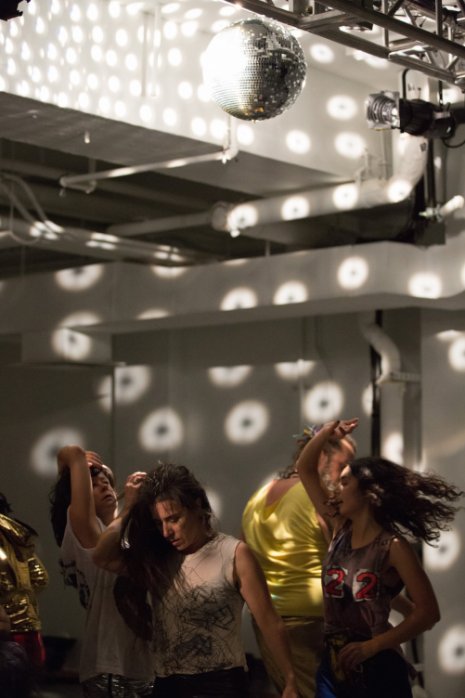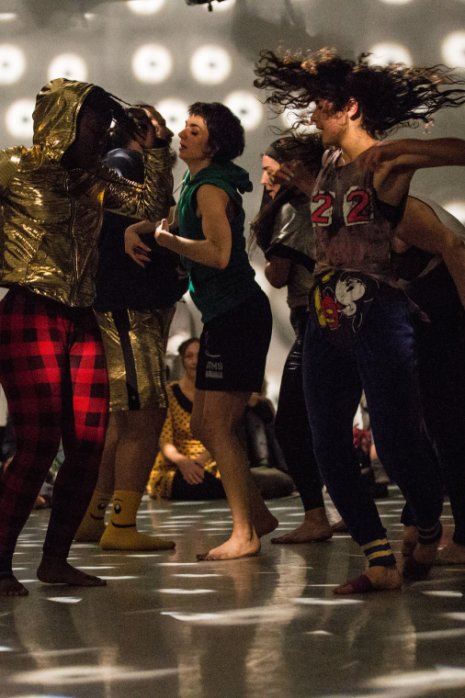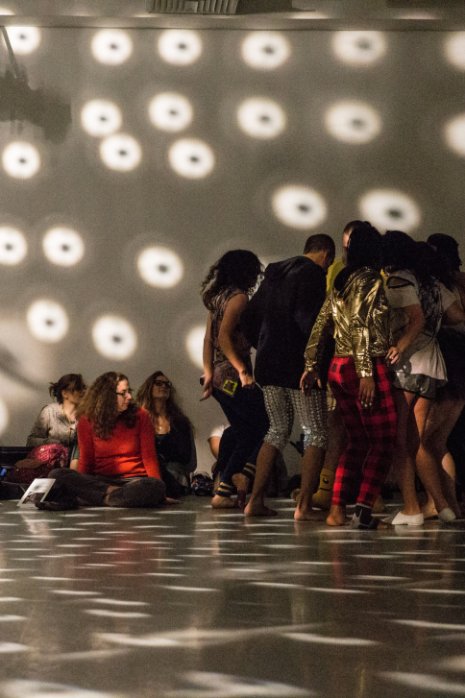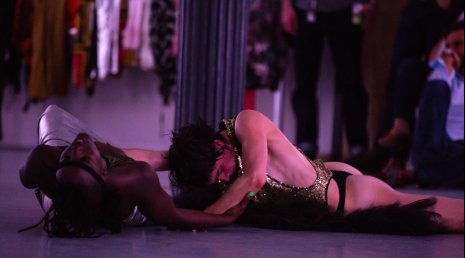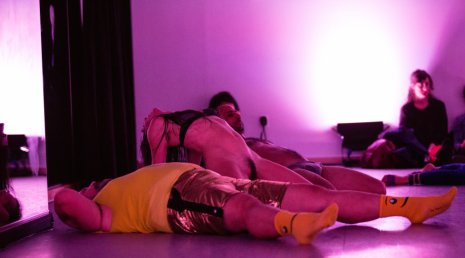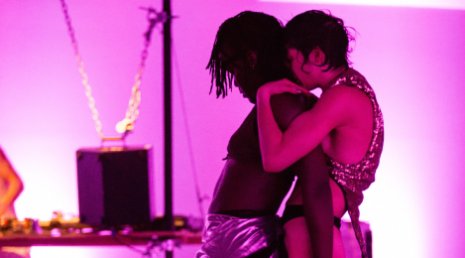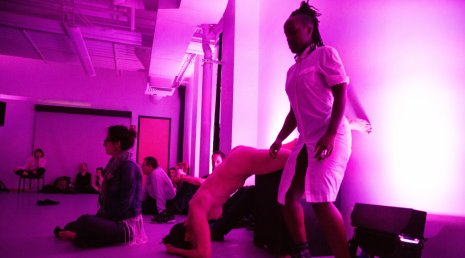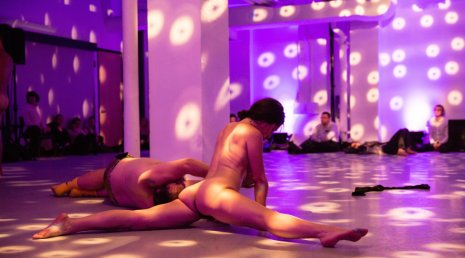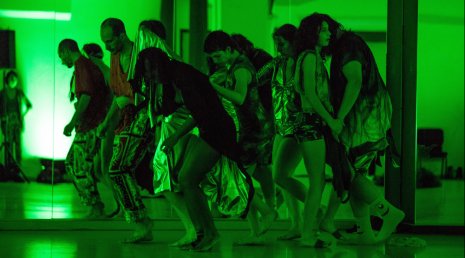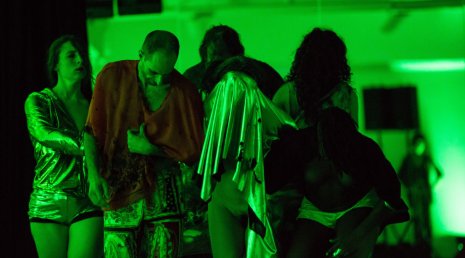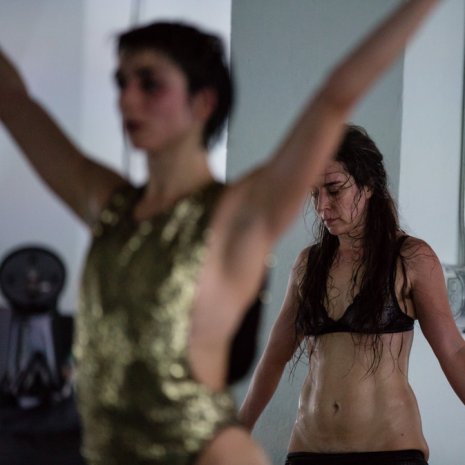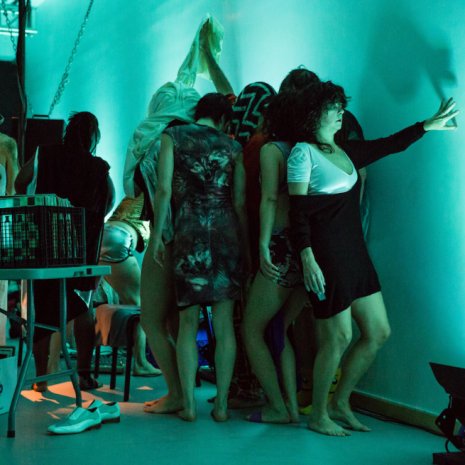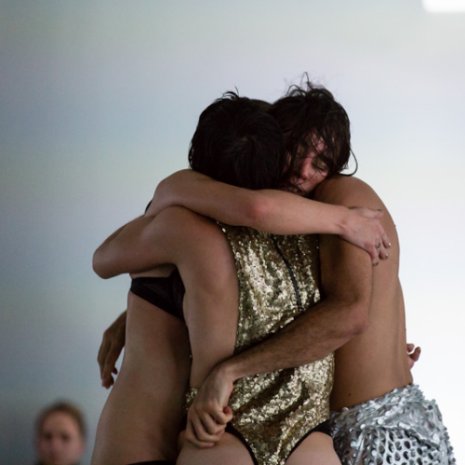Chapter Two
Yes! Yes, to all that you are saying here! Before I delve into your question regarding transformation, I have to refer to what you mentioned before. I love how you're saying that there's an "ambiguous presence of the sacred...as something that can be felt but not completely viewed." This ambiguous presence of the sacred emerged also almost on its own - meaning not as a conscious decision, or at least not at first - and is directly related and comes from experiencing the repetitive action of being a collective of women engaged together in a deeply embodied practice of exploration, inquiry and transformation.
In 2008, when we were performing “The Sublime is Us” upstairs in the studios at Dance Theater Workshop (now New York Live Arts) in NYC, there was this sense of a sacred presence. I had gotten a commission to present work in the theater but had chosen to invite the audience into the studios (the space where the work had been made) instead. The studio had a whole wall made of glass, so that when the performance would start there would still be light coming in through that back wall and as the show progressed the night came down upon us and became part of the lighting and overall feeling and influenced the way the audience experienced the whole thing. One night - which also happened to be Halloween night, by the way.. ha! - there was a storm and, needless to say, the sounds and lightning of the storm became part of the performance as well. To our and the audiences delight (even a superstitious delight for some!), in the climatic moment in which we'd get in a circle and start drawing our arms up and over our heads and drawing them from behind us around, up and in front of us into the center of the circle with our whole bodies as if we were harnessing the energy of the whole room, and everything that had happened up until that point. Right at that moment we were containing it and turning into a shared energy center point right in front of our collective pelvises a lightning strike followed by super loud thunder broke! It was an amazing moment of synchronicity. It felt as if we had been connecting to the night and the weather through our bodies and our semi-ritualized performance and that we had achieved such a symbiosis with the present moment and with our environment that we had brought on the lightning and the thunder ourselves!
Although I truly believe that it was purely coincidental that it happened at the same time, there was still something magical about that performance for the audience; it felt that what we were doing was magical, beyond the artifice of the theater; or perhaps that this work was interested in the relationship and question of the role of theater in our society, and, in turn, its role in how theater connects or disconnects us with nature. From that night on I realized that, as utopian and fantastical as it might be, I was interested in continuing to make work from a place of faith in the transformational potential of bodies coming together and making change, making change first in ourselves, in our own bodies, then as a collective, as a coven of witches making magic and affecting change in the space and in the people present, and ultimately to ripple out of the walls of the theater and into the world and through this metaphoric moment even believing that we could change the weather with the healing powers of our pelvises, our wombs, our pussies!
Two things about this work, “The Sublime is Us,” are worth mentioning: the fact that I chose to invite the audience into the studio, our workspace, as opposed to the usual path of taking the studio work into the theater to share or "present" it to the audience. I chose to do that partly as a way to resist relating to the work as a product, to resist the notion that we work in the studio to "manufacture" a piece and then transport it to the theater space where we "package" and "serve" or “sell” it to the audience as consumer. In the process we were working less in a creating-a-piece mode and more as a searching for a way to allow the work to grow more organically. We would improvise, talk a lot and search for ways to achieve what I called "performing desire" or embodying our own desire. During that process we would allow the form and composition of the piece to "grow" almost on its own. My relationship to the work was more like tending a garden then designing a piece. Also, in the middle of this process, I became pregnant with my son. I was experiencing a really odd parallel between my own transformation, growing another body in my own womb, and noticing that the studio and the way we were working was functioning more as a womb than a factory or a place of work. The studio felt like the womb for the piece; we even started using that language during the process, treating the walls of the studio as membranes, and walls of the placenta, and the space and the air as nurturing and transforming and growing our bodies. So when I invited the audience into the studio I invited them into the womb.
The second aspect that feels worth mentioning was the fact that I placed the audience in front of the studio mirrors, so they had to experience the piece through the mirror and see themselves watching, becoming participants, or having to choose to turn around when they wanted to see something without seeing it through its image. My original intention was to make the audience more obviously conscious of their role as voyeur and to make it practically impossible for them to forget their own presence and their part in the performance. This desire to make them hyper conscious of their role as audience has been a huge part of my work and continues to inform the content and the different forms that the work takes.
What most inspired and intrigued me during this process, and what became very much the content of that work, was the relationship between our three dimensional, living, breathing, organ, fluid filled bodies, the felt experience and its energetic field, and the image of ourselves in the mirror. We made the piece almost always looking at our own image in the mirror, having to constantly be in the space between the experiential awareness of being and the awareness of our images. This continues to be a fascinating issue for me not only in our daily experience and relationship with our self-image but in terms of what dance is as a form. Dance is both super visual - we, as viewers, take it in first through our eyes - and profoundly felt, experiential and energetic, even potentially alchemical. With this work I was intending to bring this dual nature to light, in an attempt to give the audience a more extreme experience of both of these aspects almost like a chemical experiment where one separates the elements of the substance that one is dealing with. But my desire is to celebrate and integrate the relationship between the two factors, to resist the simplified view of dance as only visual and spatial design, and to kneel down in awe of the mystery of the energetic and unknown within and between our bodies.
I believe that it was partly through this investigation of the relationship-contradiction-dichotomy between the image and the experiential and the energetic aspect of dance as a form and of being live bodies that the sacred and the ritual emerged. Once again I feel paralyzed by a fear of over simplifying the history of the process and the depth (if I may say so myself) of what the work is doing by trying to write it down. I think that it was perhaps in the investigation of what is the labor of dance, the labor in making a dance and the labor of the dancer without relegating them to a secondary action that has its sole purpose in the creation of a production of a dance as product. In desiring to question where value lies and thus placing value in the labor itself transforms it from an experience of labor, effort, doing as work or a means to an end as an effort exerted to make a product to the exaltation of the being in the experience of the laboring itself. In other words, dance emerges necessarily as a celebratory ritual of experiencing the lived body and within this ritual that emerges, just like the circles and the repetitive and mirroring forms emerged, the sacred appears because we are unknowingly paying homage to the esoteric nature of being in the bodily forms that we are in and that reminds us of our evolutionary past and of our connection to nature and the planets and the stars and our inseparability from one another...This is where I feel like dance gets super hippie and spiritual. I used to feel almost ashamed of it but I have finally learned to be unapologetic about it and embrace it, as I have come to realize that all of these processes and dances and dancing with each other have taught me and continue to teach me more and more about the illusion of separation and the illusion of the self as separate from the other; to dance together and at times with an audience is a practice of empathy.
But I digress. Another important relationship to the sacred in my work, always a very conscious decision, is to treat the moment when the work is presented to an audience as sacred, treating this exchange or moment of making contact with total and complete solemnity. It is a moment to be cherished and celebrated in all its symbolic potential and not to be taken lightly. This is what makes theater theater: this moment. I am not making work as a way to engage in a market or in a monetary exchange but rather to push dance, in the context of theater, closer to a something much more mystical, magical, connected to the gods and the universe than the more simplified market driven bourgeois mode of presentation.
Going back to your question regarding the role of transformation in my work, it would be easiest to take this last piece, “The Sublime is Us,” as a point of departure or bridge to a way of making work where transformation and healing were key elements, consciously sought and part of the original intention. One could say that I had started to experience a transformation as a maker from identifying with a notion of the artist as master or a designer to shifting towards identifying myself more and more as a shaman or healer. Writing this I feel almost embarrassed to admit this artist-as-healer or shaman identification because it seems slightly delusional or like I am very full of myself. However, when I ask myself “why make art?” and, particularly, “why make dances?” my honest, somewhat naive answer is that I want to heal myself, the performers and the audience from the maladies of our time, particularly the malady of Cartesian thought - "I think therefore I am" - which I believe continues to plague us because we carry this in our perception of ourselves and the world we experience ourselves in. I suspect that it has taken me this long to let go of my fear and embarrassment, to fully step into my 'power,’ most likely because I was raised as a woman to feel not so entitled and that to think so highly of myself was pure ego and selfishness. It has been a really long road of letting my body, my practice and my own personal 'embodied rebellion,' as I like to call it, offer me enough freedom from shame and self criticism to be able to now unapologetically feel strong and bold enough to say that I am making theater as a space of utopia, a space for the possibility of transformation and healing. As I mentioned before, the healing is from Cartesian dualist thought; and thus from the burdens of being in Western civilization, ruled by European colonialist thinking. This is why I have been calling what I do less “making pieces” and more a transformational practice, a practice of becoming uncivilized and decolonized.
The role of transformation in my work probably started early when I was making the series of pieces with the same group of female dancers, all wearing the same navy blue uniforms. I wanted us to have the same costumes because I wanted to resist what felt like pressure from the way our careers as choreographers are modeled by grant funding cycles and presenting organizations, etc. to create a whole new work with a whole new idea or proposition and new music design, lighting and costumes to complement or literally "dress" the work. This felt too much like ‘product.’ I felt like I needed to make choices about the lighting, music and costumes that would not separate them from the work but rather feel like necessary and inextricable parts of the totality of the work. The choice of the worker's uniforms comes out of this way of working with costumes and also the use of them in every new piece, the refusal to use a new set of costumes is a way to put forth more clearly that each new work is not separate from the previous one and that my interest is not in making a perfect new piece. Rather it is calling attention to the dancers themselves and their transformation from piece to piece; to say that it is about the dancers themselves, about their labor, the labor of their bodies, the labor of dance, the labor of love.
After “The Sublime is Us” I no longer worked with those uniforms and with the same group of dancers. That work felt like the bridge from making work still in a representational mode to shifting towards a more rigorous search for the actual method and the work itself be the ideas rather than just representing them. This also coincided with my son's birth; my own body and life had been forever changed.
The role of transformation in my work is connected to the key question that comes up for me with each new creative process I engage in: "why make art?" and "why make dance now?” Through the years I've come to realize that my fascination with making dances also is deeply connected with the question "why dance in the context of theater?" In my very non scholarly way I go back to the very beginning of Western theater and how it appears, as far as I understand, simultaneously at the time when the democratic societal model begins, coinciding with the beginning of what we consider Western civilization and thought. Without doing the scholarly research that maybe one day I'll have time to get into and do, I "work that question out" in my processes.
There are different valid 'raisons d'être' that art may take on. I have come to realize that my approach to making theater is coming from the place of the theater as a space of possibility, both of liberation of that imposed "order" currently prevalent in society and from the realization that the theater can be a space for practicing utopia, a playground of ideas and possibilities, where perhaps we discover that indeed another world is possible.
This led me to working with the dancers in a completely different way, especially in my latest work, “An Epilogue for OTRO TEATRO: True Love.” I decided to further resist making dances as products. Instead I tried to shift the model to one where the work and the process itself had to "serve" the dancers; we made the work as a way to experience individual transformational healing for each one of us and for the group as a collective so the work was for us to be in our practice and not to create something. The performance was a ritual of transformation shared with the audience with the hope imbedded within it that, in sharing the space with us and possibly joining in if they so desired, they too could become healed and liberated. The piece became the sharing of the memory of our process, the sharing of our practice and our transformation.
I would say the focus of my research is to find a way to make my whole practice, including teaching and my own embodiment part of my artwork. I am interested in taking the path of transformation and self healing - what I call growing myself a new body, a utopian body - to its end, or at least to where it leads me. I consider my body as the venue and the frame, not the proscenium stage. I am not sure yet what that means in terms of how that will develop into a performance, but I am interested in experimenting further with the possibility of performance as a ritual of becoming; in this case at a cellular level. Perhaps this will mean doing an even longer performance - last two works have been 2-3 hours long - so that I can experiment in ways to actually transform in the presence of an audience. I am still grappling with the question of how to empower or inspire them to be transformed themselves without confronting them and demanding that they “participate” in the way that we often expect participatory theater to engage audiences, where they feel put on the spot. I am more interested in enabling a deeper -also cellular - kind of transformation that begins from an empathetic experiencing of the performance event.
I feel that the whole history of all of the creative processes that I’ve engaged with have transformed me mostly into an artist less interested in achieving a sense of mastery or excellence of design into an artist ever more interested in how what I make may affect change in our perception of ourselves and the world. I feel that the act of making work and the nature of the kind of explorations that I’ve engaged with, always in a very collaborative setting, has made me both more humble and less attached to the needs for recognition and adulation that my ego craved for in the beginning. At the same time I feel more confident and unapologetic, as well as more courageous and willing to take risks.
The most tangible change in the way I make and think about making work came from the development of what I call “the practice of being in pleasure.” This method of working was a result of all the previous years of working but was specifically born during the process of creation for OTRO TEATRO, which premiered at the Walker Art Center in February 2014. It came out of a desire to further commit to the idea of being a choreographer more as a teacher, as someone who gives and inspires a way of being in the body that might result in a way of moving, rather than as a designer who imposes her way of moving as a style, moving bodies around in space. I found a method to inspire a kind of embodiment without imposing a particular specific movement. This practice of being in the pleasure of being in one’s body, through time allows one to become liberated from a white European standard of beauty and order in the body that I had been trying to liberate myself and my dancers from. It is a practice that allows one to give a voice to the body, the flesh, the instinctual, the repressed, the primal and animal in us, and it allows us to let go of shame and repression. It is a very healing practice although it can be very challenging and painful at times, because whatever is present in the body at that moment, either in ones own body or in the room between the bodies, comes to the surface and necessarily has to be dealt with.
Having found that method of working – the Practice - felt almost like a revelation, like it was a culmination of all the years of previous research! It felt like it hit the crux of what my work was about ideologically, aesthetically, and the relationship between the two. It felt like it was both undoing that capitalist model of production and hierarchical structure of making by giving the dances complete agency. At the same time I was able to put forth my vision as an artist and author simply by the process of becoming uncivilized, shifting knowledge from the naming, defining, separating brain to other possible experiential ways of knowing that are possible by being a live sensing body.
I became so fascinated by this practice and its layers of complication and possibility, and began “The Pleasure Project” together with the core group of performers I had been working with when making OTRO TEATRO. This ongoing project takes “the Practice” outside of the rehearsal studio and outside of the theater into public space, in what I call a kind of procession or ‘preaching outside of the choir,’ investigating the role of a body in public space; what is allowed and not allowed, and bringing to light how practicing the pleasure of simply being in our bodies is an act of resisting a system where value is placed only in production and consumption. This project completely collapses the process and the product since when we do it we are both rehearsing, performing and also simply ‘doing the practice.’ It feels like activism and protest but via alchemy, literally practicing what we preach, rather than simply preaching.
I say simply preaching because now with the world in such a dire situation, when it feels like there is so much work to do with direct action: aiding refugees, resisting fascism, engaging in social justice actions, etc, etc… Making art seems like a potentially frivolous practice. However, I have been battling with these same questions regarding the function or the potential for art to change the world. I came to realize that the only hope for change is a deeply internal one that comes from within each of us. I like to call it an “embodied rebellion” rather than a revolution. I believe that the role of art is to make change at a very abstract, energetic, vibrational, perceptual level. By abstract I mean not literal or representational, not as direct action, but changing our mindset or perception and consciousness in ways in which at first are only experienced in a subconscious and unknowable way, just like hearing music or viewing abstract visual art changes us. And I feel compelled to make theater because it is a space for utopia, to practice new ways of being, to practice empathy, to practice loving, to practice letting go of the illusion of separation, to build - or to grow as I prefer to term it - another kind of theater, OTRO TEATRO, that can perhaps let us peek into another possible non-patriarchal, white supremacist colonialist, dualist, violent world.
*********
An artist and researcher based in Uruguay, Lucía Naser is interested in living, dancing, experimenting, researching, transforming and writing with others. She is a sociologist with a PhD in Romance Languages and Literatures from the University of Michigan and a Master in Performing Arts from Universidad Federal de Bahia.


